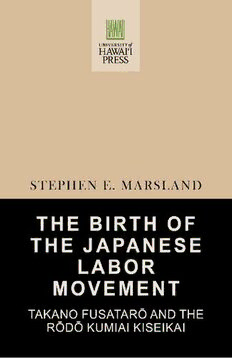
The Birth of the Japanese Labor Movement: Takano Fusatarō and the Rōdō Kumiai Kiseikai PDF
Preview The Birth of the Japanese Labor Movement: Takano Fusatarō and the Rōdō Kumiai Kiseikai
The Birth of the Japanese Labor Movement TakanoFusatarō.(CourtesyofIwanamiShoten) The Birth of the Japanese Labor Movement TAKANO FUSATARŌ AND THE RŌDŌ KUMIAI KISEIKAI Stephen E. Marsland Open Access edition funded by the National En- dowment for the Humanities / Andrew W. Mellon Foundation Humanities Open Book Program. Licensed under the terms of Creative Commons Attribution-NonCommercial-NoDerivatives 4.0 Inter- national (CC BY-NC-ND 4.0), which permits readers to freely downloadandsharetheworkinprintorelectronicformatfornon- commercial purposes, so long as credit is given to the author. Derivative works and commercial uses require permission from the publisher. For details, see https://creativecommons.org/li- censes/by-nc-nd/4.0/. The Creative Commons license described above does not apply to any material that is separately copy- righted. Open AccessISBNs: 9780824883874 (PDF) 9780824883867 (EPUB) This version created: 5September,2019 Please visit www.hawaiiopen.org for more Open Access works fromUniversity ofHawai‘i Press. ©1989UniversityofHawaiiPress AllRightsReserved CONTENTS Preface ix 1 The Setting 1 2 Takano Fusatarō 46 3 Birth ofthe LaborMovement 62 4 The Metalworkers’ Union 74 5 Growth ofthe LaborMovement 87 6 The Turning Point 112 7 Crisis andCollapse 126 8 Legacy ofthe Movement 148 Appendixes 159 A Constitution ofthe Alliance forIndustrial Organization 161 B Constitution ofthe Tokyo ShipCarpenters’ Union 167 C “ASummonstothe Workers” 172 D Rules ofthe RōdōKumiai Kiseikai 180 E Constitution ofthe Metalworkers’ Union 183 F Constitution ofthe Reform Society 195 G Printers’ Friendly Association Rules 201 H Proposed Factory Lawof1898 204 I Constitution ofthe Printers’ Union 211 J Reference Tables 220 Notes 225 Bibliography 249 Index 267 viii PREFACE This work has two purposes. The first is to chronicle the birth of the Japanese labor movement, which until now has received only afewscantpagesinotherworks.Thesecondistodocumentearly unionstructures,constitutions,andideologyforthosewhowishto comparetheearlyJapaneselabormovementtothatofothercoun- tries. Many books that deal only briefly with this period contain errors and inconsistencies, or omit notes to explain sources. Ac- cess toLaborWorld, the labor newspaper ofthe period, andother documents recently compiled by the Tokyo University Committee on Labor Movement Documents enabled me to resolve many of these problems. I am deeply indebted to this committee, whose careful research made this bookpossible. ThroughoutthebookIhavegivenJapanesefamilynamesfirst, which seems most natural to me. I have used the Hepburn system at the publisher’s recommendation even though I prefer the sys- tem developed by Eleanor Harz Jorden, which I feel more closely parallels howthe Japanese write inhiragana. Labor World had both English and Japanese sections in each issue. A typical issue was ten pages, nine in Japanese and one in English. From the perspective of an English reader, the Japanese title, Rōdō Sekai, appeared on the last page. The English title, La- bor World, appeared on the first page. Issues were numbered in Japanese sequentially from one to one hundred. The English title page carried a numbering system of volumes and numbers. Thus theissuenumbered67inJapanesewasvolumethree,numberone inEnglish.PaginationstartedfromtheJapanesetitlepage,except that the English title pagewas unnumbered. ix x Preface To avoid confusion, I have used the English title, Labor World, but followed the Japanese numbering system. Thus the English ti- tle page in a ten-page issue would be page ten. Quotations are fromtheEnglishsectionexceptwhereIhaveindicated“mytrans- lation.” I owe a great deal to many individuals who helped in the creation of this work. I began work on this manuscript during my junior year abroad at Keio University while a student at the New York State School of Industrial and Labor Relations at Cor- nell University. Professors at both schools, as well as scholars and staff at the Japan Institute of Labour to which I was attached that year, guided and assisted my studies. Professor Emeritus Alice Cook directed my research from Cornell, while in Japan Profes- sor Komatsu Ryūji of Keio took me under his wing and fueled my interestintheMeiji-period labormovement.IamindebtedtoPro- fessors John P. Windmuller, Gerd Korman, and Walter Galenson at Cornell, who fostered my love of history, economics, and com- parative industrial relations. In Japan Professors Sumiya Mikio, Ōkōchi Kazuo, Iida Kanae, Ōshima Kiyoshi, and Umetani Shun’- ichirō all took time to clarify various aspects of Japanese labor history. Hirota Osamu and Yamamoto Hisao at the Japan Institute of Labour went out of their way to make me feel at home and intro- duce me to scholars in the field. Professor Earl Kinmonth was kind enough to evaluate and direct editing of the manuscript whileIwasatCornell,andProfessorsSolomonLevineandRobert Cole offered much encouragement while I was rewriting the manuscript. My parents, Bill and Amy Marsland, did an excellent final editing. The best support a man could ask for was given by my wife Yaeko, who strongly encouraged me to finish rewriting the manuscript. Early Japanese labor history fascinates me because it rep- resents an early convergence of Japanese and American ideas. The founder of the Japanese labor movement traveled to the United States and studied American unions for years. He be- came an organizer for the American Federation of Labor and wrote many articles for the Federationist. Labor World’s English section reflects this close association, as does the fact that many of the original source documents are in English. The blend of Japanese and American labor ideologies created at that time,
